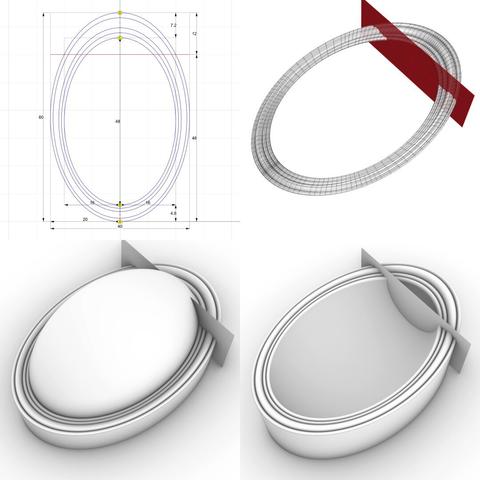See
https://pixelfed.social/p/Splines/796798349526747214 and
https://pixelfed.social/p/Splines/796786779066451143 for detail.
Just like
#ArcZero in the
#spiral for the
#IonicVolute, the plan for
#EggsAndDarts starts out larger than what is eventually used.
The outermost frame is 7.5 parts or 60 units tall (from A to D), and 5 parts or 40 units wide when µ = 144. The innermost frame is 6 parts or 48 units tall (from B to C), and 4 parts or 32 units wide.
The height and width for both inner and outer are in 3:2 ratio. The difference in height is also split in the ratio 3:2. So, the gap between A and B as 12*2/5 = 4.8, and the gap between C and D as 12*3/5 = 7.2. We then divide both of these gaps in 5 equal segments shown by the dots between them.
Create an ellipse to fill the outer frame, and another to fill in the inner frame. Then interpolate them to create 4 more through the dots, only to delete the 3rd ellipse. This gives us the 5
#rails for sweeping the rim of the egg.
Create circles perpendicular to and touching adjacent pairs of rails, and then
#sweepTwoRails using the circles to get the rim shown in the top-right. The red cutting plane marks tentative slicing for eggs.
The bottom left image shows a convex egg created with an
#ellipsoid that is 48 units tall, 32 units wide, and 32 units deep. This is equivalent to
#revolving the innermost ellipse around its major axis. Only half of this egg is above the oval slab.
The bottom right image shows the concave variant which is created by performing a
#booleanDifference between the oval slab and the round egg created above. The top portion of the egg is removed in the concave variant, but the convex variant must still account for the bulge of a fully round egg. As such, the slab heights of the convex and concave variant are different. I will show the measurements later.
To create the slabs for the convex and concave variants,
#extrude the outermost ellipse according to their measurements and
#cap #planarHoles.
